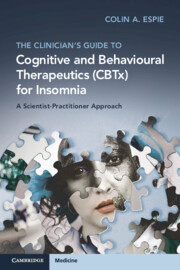 The Clinician's Guide to Cognitive and Behavioural Therapeutics (CBTx) for Insomnia
The Clinician's Guide to Cognitive and Behavioural Therapeutics (CBTx) for Insomnia Published online by Cambridge University Press: 20 December 2024
I trained as a clinical psychologist in the late 1970s, qualifying in 1980, and began practising in the local primary healthcare services in NHS Lanarkshire in Scotland. It was in that context that a general practitioner (GP) asked me one day, likely in 1981, ‘Colin, is there not anything you can do for folks who can’t sleep?’ I had to say that I didn’t know. We hadn’t had much, or even any, training on sleep problems. The GP concerned, along with many other professionals who referred patients, wasn’t satisfied that a pill was the only, or even the best, answer to mental health conditions. I had been seeing people with depression, anxiety, and so on, but could insomnia be addressed using evidence-based psychological therapies? I was curious to find out.
To save this book to your Kindle, first ensure [email protected] is added to your Approved Personal Document E-mail List under your Personal Document Settings on the Manage Your Content and Devices page of your Amazon account. Then enter the ‘name’ part of your Kindle email address below. Find out more about saving to your Kindle.
Note you can select to save to either the @free.kindle.com or @kindle.com variations. ‘@free.kindle.com’ emails are free but can only be saved to your device when it is connected to wi-fi. ‘@kindle.com’ emails can be delivered even when you are not connected to wi-fi, but note that service fees apply.
Find out more about the Kindle Personal Document Service.
To save content items to your account, please confirm that you agree to abide by our usage policies. If this is the first time you use this feature, you will be asked to authorise Cambridge Core to connect with your account. Find out more about saving content to Dropbox.
To save content items to your account, please confirm that you agree to abide by our usage policies. If this is the first time you use this feature, you will be asked to authorise Cambridge Core to connect with your account. Find out more about saving content to Google Drive.